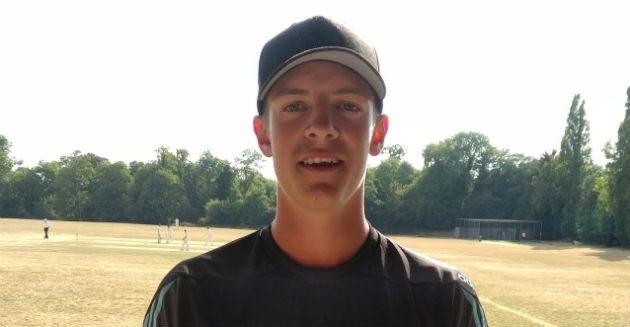Without any schools cricket last summer, Wisden Cricketers Almanack took an inventive look back into the history of schools cricket and highlighted some outstanding young players. Richard Spiller explains.
School pupils around the country are getting back on the field in April, some of them for the first time in two years.
The schools section of Wisden Cricketers Almanack – the 158th edition has just been published – always contains a fascinating collection of those who might be, could have been and never were, along with the greats of the game.
The absence of cricket in schools in the pandemic year of 2020 left an obvious gap in Wisden but the game’s greatest authority has filled it in enterprising manner.
It was not until 2007 that the Wisden Schools Cricketer of the Year was inaugurated but cricket in schools have been covered by it since 1865 – a report of Eton v Harrow appearing in the second edition – while averages have appeared in every almanack since 1887, even world wars failing to stop the game.
Last summer was different, though, with pupils locked down for the early part of last summer, when the vast bulk of cricket in schools is played. So Wisden’s correspondent Doug Henderson – plus editor Lawrence Booth and his team – went back to 1900 to nominate a player for each season.
Among the nominees are nine players who went on to play first-class cricket for Surrey, some only briefly while others went on to the highest level.
The first was Jack Crawford in 1905, rewarded for a superb season at Repton School in which he scored 766 runs and took 51 wickets. So brightly did he shine that Crawford’s rise towards being one of the greats of his time seemed unstoppable when he became the first teenager to be capped by England, making his debut against South Africa at Johannesburg in January 1906, aged 19.
Yet Crawford was to play just 12 Tests and his career was marked with disputes, first falling out for Surrey and then South Australia before settling in Otago. He returned to The Oval after the First World War but was never quite the same force, although many would be happy to retire with 9,488 runs and 815 wickets at first-class level. If you want to know more about Jack Crawford’s life and career, former Surrey scorers Keith and Jennifer Booth published Rebel With a Cause: The Life and Times of Jack Crawford in 2016.
Four years later came Percy Fender, recognised for 754 runs at 43 and 34 wickets at 15 for St Paul’s. That highlighted the all-round talent which made him such a force for Surrey, although he made his first-class debut for Sussex. Moving north, and then losing four years of his career to the First World War – in which he fought for the Royal Flying Corps – Fender became Surrey’s captain as they rebuilt after the conflict, playing any number of barnstorming innings and bowling a mixture of seam and leg-spin. With glasses perched on the end of his nose, he was one of the most recognisable players of his age.
Not only was he a key player, doing the double of 1,000 runs and 100 wickets in six seasons, Fender quickly established a reputation as an inspirational and shrewd leader, captaining the county for 11 seasons. Yet even his inventive mind found the challenges of a limited attack and the plumb pitches at The Oval of that era more than he could overcome to claim the County Championship.
Like Crawford, Fender had a habit of annoying those in power which was why he never captained England – he played just 13 Tests – despite being revered by his fellow players.
Spencer Block was nominated in 1926, on the back of 698 runs at 53 plus 15 wickets for Marlborough College, going on to score centuries for both Cambridge University and Surrey. Yet his first-class career lasted little more than five years, Block’s abilities as a gifted sportsman seeing him play hockey for England and excelling at golf and tennis.
Such was Patrick Dickinson’s excellence as a schoolboy cricketer that he was nominated in two successive years, 1936-37, following 948 runs at 118 and 22 at 14 with 1,061 at 81 and 47 at 14 for Kings College School Wimbledon.
A century for Cambridge University in the 1939 Varsity Match followed, also appearing for Surrey that season, but the Second World War intervened and after that Dickinson’s cricket was played in India, appearing first for Bombay and later Madras.
Among Surrey’s nine the most accomplished is Peter May, whose 651 at 81 runs for Charterhouse gained him the nomination for 1947. Within three years he was playing for Surrey, his England debut coming within a year, and many believe he remains the finest English batsman to emerge since the Second World War.
Despite having played his last Test aged 31 – his health was less than robust – the tall right-hander’s 66 appearances yielded 4,537 runs and in the first-class game May amassed 27,592 at 51, his strokeplay highlighted by a devastating on-drive. Captaining England 41 times, he took over from Stuart Surridge as Surrey skipper for the last two of their seven successive County Championship titles between 1952-58, going on to be chairman of the England selectors. He was awarded the CBE in 1981.
Dudley Owen-Thomas was another to emerge from KCS Wimbledon, 815 runs at 58 and 48 wickets at 12 apiece earning him the 1967 nomination. Like May he was also named as the Cricket Writers Club’s young player of the year, in 1972, and played for Cambridge University but style was not matched by substance and his first-class career faded away.
Nine years later came Ian Payne after a summer in which he scored 1,144 runs at 52 and took 79 wickets at 8.68 for Emanuel School. Payne’s all-round talents earned him a place on the Surrey staff, gaining two ODI caps for England U19 in 1977, the same year as his first-class debut. Payne, who bowled medium-pace, could not establish himself in the county side, later moving to Gloucestershire and then appearing for Shropshire in the Minor Counties Championship.
Just 16 years old, Richard Nowell hit seven centuries for Trinity School among his 1,505 runs at 79 while 64 wickets at 14 turned the 1992 award into a no contest. The left-arm spinner flickered briefly for Surrey but his first-class career stretched to only a dozen games.
When Richard Clinton arrived at The Oval, he was already a familiar figure for Surrey members, following in the footsteps of his father Grahame, also a doughty opening batsman. The left-hander’s 963 runs at 107 for Colfe’s School gained him the Wisden nomination, aged 15 in 1997, and he began his first-class career at Essex before by a five-year stint at The Oval.
Since the award was formalised, one Surrey youngster has been recognised – Nathan Tilley’s 1,256 runs for Reed’s School saw him named in the 2018 almanack and, although he has yet to break into first-class cricket, there is time yet.










